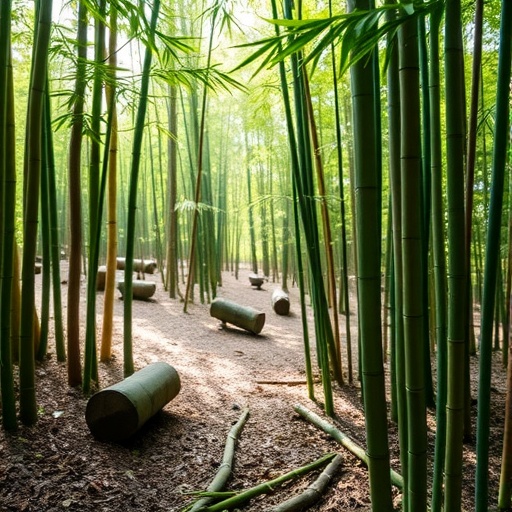In a world increasingly beset by the impacts of climate change and land degradation, the quest for sustainable solutions has never been more urgent. A pivotal piece of research has surfaced from eastern India, shining a spotlight on the potential of bamboo—often dubbed “Green Gold” due to its extensive uses and eco-friendly nature. Conducted by Garai, Malakar, Mishra, and their team, this study meticulously explores the most conducive habitats for three economically vital bamboo species. The findings promise not only to bolster local economies but to contribute significantly to environmental restoration.
As the world grapples with diminishing resources and heightened pressures on land caused by industrial activities and urban encroachment, bamboo emerges as a natural ally. Known for its rapid growth and remarkable adaptability, bamboo can play a critical role in soil stabilization, carbon sequestration, and overall land restoration. The research conducted by these scholars delves into various ecological parameters to identify optimal growth areas for these bamboo species, revealing insights that can empower local farmers and communities.
The first of the bamboo species under investigation is Dendrocalamus strictus, a species recognized for its versatility and strength. It serves not only as a construction material but is also a significant component in traditional handicrafts. Its dense root system can improve soil quality and prevent erosion, making it particularly useful in hilly terrains prone to landslides. The study emphasizes the necessity of planting this species in regions where the land has been heavily degraded or where environmental damage has resulted from unsustainable practices.
Alongside Dendrocalamus strictus, the researchers assessed Bambusa vulgaris and Phyllostachys edulis, each renowned for their rapid growth and economic benefits. Bambusa vulgaris, with its large, hollow stems, finds application in making furniture, household goods, and artisanal crafts. Phyllostachys edulis, also known as moso bamboo, is prized in culinary contexts and is sought after for its edible shoots. Their growth in appropriate habitats will not only cater to local demands but also foster biodiversity by offering habitats for various fauna.
The methodology employed in the study is as innovative as it is indispensable. By integrating remote sensing technology and Geographic Information Systems (GIS), the researchers meticulously mapped potential habitats based on climate data, soil composition, and topography. Such a scientific approach underscores the need for data-driven environmental practices, aiming to guide effective planting strategies tailored to each species’ requirements.
The study’s findings have immediate implications for policymakers and conservationists. With bamboo’s ability to thrive in marginal lands, governments can shift focus toward sustainable development by encouraging the cultivation of bamboo in degraded landscapes. This practice not only rehabilitates the land but also offers an economic incentive through the creation of green jobs and alternative livelihoods, reducing reliance on economically exploitative industries.
Moreover, the study elucidates the role of bamboo in mitigating the effects of land degradation—a pressing challenge faced by many regions globally. Bamboo forests can reverse soil degradation processes by enhancing soil fertility and reducing runoff. This dual benefit of environmental restoration and economic upliftment highlights the importance of integrating ecological knowledge into agricultural practices to revitalize communities.
As environmental degradation continues to threaten biodiversity and resources, this research sets a precedent for future studies on sustainable species selection and habitat restoration. It underscores a growing recognition of bamboo’s multifunctional benefits in improving land health while supporting regional economies. Global interest in bamboo cultivation could catalyze a shift toward eco-conscious agricultural practices that prioritize both environmental health and socio-economic viability.
The scope of this research extends beyond just the scientific community; it resonates with local farmers, community leaders, and environmental advocates. By fostering an awareness of the importance of bamboo, the study encourages grassroots movements toward sustainable land use strategies. This grassroots understanding could help fortify local ecosystems against challenges posed by climate change while improving food security and livelihoods in rural areas.
The potential of bamboo stretches far beyond its immediate economic advantages. It embodies a vision of restorative agriculture that complements traditional knowledge with modern science to achieve sustainable outcomes. In a rapidly changing world, the insights provided by Garai and colleagues herald a promising shift towards more resilient agricultural systems that prioritize environmental stewardship.
With the release of this crucial research, eastern India is poised to lead the charge in showcasing bamboo’s potential as a solution to land degradation. By planting the seeds of knowledge and action derived from this study, local communities can navigate the path toward sustainable development with newfound confidence—turning the challenges they face into opportunities for growth and healing.
As this movement gathers momentum, it will undoubtedly inspire similar initiatives worldwide, seeking ecological balance and economic resilience. This research not only presents a compelling case for the cultivation of bamboo but also acts as a call to arms for all stakeholders to prioritize the health of our planet through sustainable practices.
In conclusion, the work done by Garai, Malakar, Mishra, and their associates opens a new chapter in understanding the multifaceted benefits of bamboo cultivation. It ignites hope amid daunting challenges, steering communities toward a future where economic vitality and environmental integrity coexist harmoniously, setting a robust model for responsible land use and biodiversity conservation.
Subject of Research: Habitat identification for economically important bamboo species in eastern India.
Article Title: Where to grow “Green-Gold” to mitigate land degradation? Identifying appropriate habitat for three economically important bamboo species in eastern India.
Article References: Garai, S., Malakar, A., Mishra, Y. et al. Where to grow “Green-Gold” to mitigate land degradation? Identifying appropriate habitat for three economically important bamboo species in eastern India. Discov. For. 1, 14 (2025). https://doi.org/10.1007/s44415-025-00016-1
Image Credits: AI Generated
DOI:
Keywords: bamboo, land degradation, sustainable development, eastern India, ecological restoration.




